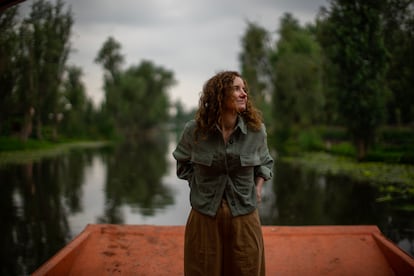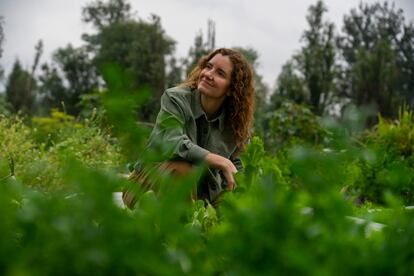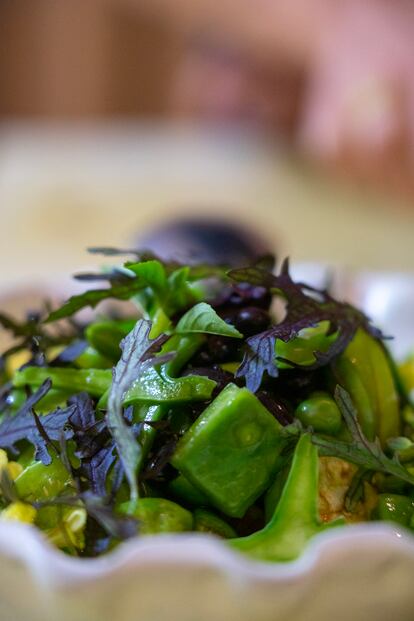Elena Reygadas: A day with the best female chef in the world
The chef-owner of the Rosetta restaurant – located in the Roma neighborhood of Mexico City – walked EL PAÍS through her day-to-day, from buying vegetables to leading her kitchen staff


The south of Mexico City still preserves the orchards that fed the ancient Mexica empire, when the entire area was a huge kind of Venice, crisscrossed with canals and lakes. On these waters, the pre-Hispanic people built a kind of islet, based on assembling palisades that they filled with mud. Today, in these fertile plots – called chinampas – all kinds of vegetables are grown.
Elena Reygadas – proclaimed as the best chef in the world in 2023 by The World’s 50 Best Restaurants list – makes her way through one of these watery paths, flanked by reeds and littlies, on her way to the fields. She greets silent, brown-skinned farmers, who are heading off to work on canoes. It’s a cloudy and cold morning that will soon end in the Rosetta kitchen. Reygadas is picking up yuca flowers, beets, papalo herbs, watercress, mustard, lemon balm leaves and prickly pears for the restaurant, which is one of the most-awarded in Latin America.
The Rosetta restaurant offers a taste of ancient Mexico. This haute cuisine (like haute couture) isn’t available to everyone… but the chef has made an effort to create culinary trends to feed the body and soul at more modest prices. In recent times, culinary temples have abandoned old glamour in search of new idols: nature, sustainability, use and creativity. Reygadas is clearly on this path. Her visit to the chinampa offers a glimpse at the agriculture that regenerates the soil… and the seasonal vegetables that she will soon serve up.

Behind the cook’s right ear – hidden by tufts of curly, reddish hair – a tattoo reveals her passion for anise flavors. The image depicts a fennel flower, its branches ending in little balls. It will be more visible when her ponytail is tied and the show begins, which, for her, starts every morning after dropping her daughters off at school. The Rosetta bakery – a dozen feet from the restaurant of the same name that she founded in Mexico, after training in New York and London – is the stage. And, before all of that, her domain was the family kitchen, where an army of relatives enjoyed the tablecloths and late-night meals. Perhaps that was when her taste for citrus was born, or her unconditional love for ripe mamey fruit.
In Reygadas’ kitchen, meat has given way to vegetables:
“My path now is to observe and respect the cycles of nature – not force them. I prefer the purity of the ingredients, in taste and aesthetics. The taste above all… but the beautiful thing is to link ourselves to the earth. I feel that nature has already made its mixtures.”
As an example: on a visit to a cacao farm, she saw that the hoja santa (“holy leaf”) grew around the beans. An aromatic plant, Mexicans use it to wrap fish, so as to give it the flavor of anise. Nature showed the holy leaf next to cocoa. Now, one of the most delicious desserts in Rosetta is a sandwich made up of two crystallized holy leaves, with chocolate mousse in between. The cold leaf crunches and the cocoa dissolves on your palate. Mexican nature is certainly haute cuisine.

Rosetta is one of the many Porfirian-era mansions that remain in the Roma neighborhood of the Mexican capital, defined by stonework, high ceilings, balconies with balustrades and ironwork. A stately wooden door topped with an arch opens onto a patio of plants and floral arrangements. Surrounded by trees, the multi-storey mansion is full of rooms, each of which offers different architectural styles to those working within them.
In one room, the confectioners prepare sweets, displaying a tray of green leaves and rose petals of various colors with lumps of sugar, like an old herbalist’s shop. Next door is the room for fresh pasta: two women spread out a fine kneaded sheet, rolling balls of cheese and dough in military formation. Then, they’ll cover it with the rest of the sheet and use a metallic mold to cut each portion in a circular manner, ready to be boiled in water.
Two rooms on another floor are dedicated to the production kitchen, where vegetables are chopped, duck is shredded and pre-cooked, or margarita scallops – one of the most unique seafoods in the Pacific – are cleaned. On the landing of the stairs, there’s space for the bar, which takes advantage of pulverized scallop shells; the bartenders distil them with vodka and use them to mix cocktails. Some drinks will taste of guava or habanero chili – the deadliest of the Mexican spices. The master mixologist will strip it of its seeds, so that foreigners can only enjoy the aroma and not burn in hell when savoring the margarita.
Meanwhile, in the basement, under a white wooden coffered ceiling, the bathrooms remind the client that this was an old house. Perhaps the space was once reserved for the coachman or stable boy.
“Hello, chef! Good morning, chef! How are you, chef?” A legion of uniformed men in long aprons greets Elena Reygadas as she passes through the house. In the past, one only had eyes for the exquisite dish served on the table… but today, the trend of haute cuisine demands that a gourmand be able to go into the kitchen, see the back room, warm up near the bread oven, greet the cooks and congratulate the chef.
While other renowned colleagues like to be in the frying pan, Reygadas acts as an orchestra director – she knows how to delegate. She oversees the kitchen, putting the finishing touches on the dishes, asking for the coral to be separated from the shellfish, checking and rechecking the ice cream and ordering it to be served on a different plate, so that the scoop doesn’t appear too big or too small. But, first and foremost, she’s thinking about what will be eaten tomorrow: how big or baked the puff pastry should be before filling it with crab, what new ingredients will come through the door, or what will be on the menu for the season. In Mexico, the dry months are giving way to the rainy season – Reygadas’ favorite time, when she gets to work with mamey fruit and mushrooms.
“You just have to observe nature; the ingredients come from the rain, by themselves,” she says.
The kitchens of Rosetta are, above all, part of a factory of ideas and creations in which the sous-chefs, the head chefs, the master pastry chef and the cocktail artists all participate – as do the sharpest interns and attentive waiters. The whole team is made up of about 80 people, without counting all the administrators, who are essential for everything functioning flawlessly.
When the first diners arrive, the stoves are all on… and they won’t ever turn off or not have a pan on them during service. There’s no time to waste. Compared to what we see on TV and in the movies, the modest size of the kitchen is surprising. And there are no copper pots in sight.
“We use stainless steel – the French use copper more, because of the heat distribution. Here, we only use the pans to caramelize [certain foods] and for the prickly pears,” Reygadas explains.
Minutes before serving the tables, through the kitchen porthole, you can see the team standing in a circle in the next room – a strange brotherhood, wearing dark uniforms and white sneakers. The Italian Giulia Giacomoni – one of the floor captains, dressed in priestly black – presides over the meeting. The latest recommendations are given to the waiters: they are asked to be attentive to the requirements of the clientele.
Some of the comments and questions overheard are as follows:
“It’s important to mention that this dish is eaten with everything – including the herbs.”
“Maybe we should leave the skin on the fish, what do you think?”
“Many people don’t expect it to taste like that…”
“If it’s rubbery, change how it’s cooked… lower the temperature and add more time, but then let them know that it will take about eight minutes to reach the table.”
After the meeting, the latest dessert is presented – everyone tries it with their teaspoons, just like the one the chef wears on the sleeve of her uniform. A teaspoon is as essential to her as the special stockings she wears to guarantee good blood circulation, as she spends at least half of the day on her feet.
A bunch of izote flowers reach the room, for the waiters to be able to show the customers what the sweet is composed of, if they ask. Everyone gets acquainted with the cascade of white flowers that are passed from hand to hand, rubbed, smelled.

The bosses and waiters alike face the hours of service with the same contained stress with which students face an exam. The daily challenge begins… and everyone is prepared. In front of the fire, a cook juggles the pan with spaghetti, propelling it like a wave, until it’s ready for the plate. Final touches, a lemon zest, some sprinkled spices, a magical touch. No shouting or fuss is heard – a tense frenzy ensues. The well-tuned orchestra has begun to sound.
The team acts as they do on any other day. Hours later, they will find out that their boss has won the award for the best female chef in the world this year. Their nerves and responsibility will surely multiply; perhaps some modifications will need to be made to the premises and new staff will need to be hired.
All this is already going through the head of Reygadas, who keeps up the surprises at Rosetta. She may also remember her time as a young apprentice, who didn’t stop making bread day after day. The best therapy is kneading dough with your hands.

Sign up for our weekly newsletter to get more English-language news coverage from EL PAÍS USA Edition
Tu suscripción se está usando en otro dispositivo
¿Quieres añadir otro usuario a tu suscripción?
Si continúas leyendo en este dispositivo, no se podrá leer en el otro.
FlechaTu suscripción se está usando en otro dispositivo y solo puedes acceder a EL PAÍS desde un dispositivo a la vez.
Si quieres compartir tu cuenta, cambia tu suscripción a la modalidad Premium, así podrás añadir otro usuario. Cada uno accederá con su propia cuenta de email, lo que os permitirá personalizar vuestra experiencia en EL PAÍS.
¿Tienes una suscripción de empresa? Accede aquí para contratar más cuentas.
En el caso de no saber quién está usando tu cuenta, te recomendamos cambiar tu contraseña aquí.
Si decides continuar compartiendo tu cuenta, este mensaje se mostrará en tu dispositivo y en el de la otra persona que está usando tu cuenta de forma indefinida, afectando a tu experiencia de lectura. Puedes consultar aquí los términos y condiciones de la suscripción digital.
More information
Archived In
Últimas noticias
There is as much life left to discover on planet Earth as that which is already known
Dozens presumed dead, around 100 injured in fire at Swiss Alps bar during New Year’s celebration
Is porn for women different from conventional porn? We spoke to those who make it
Cartagena de Indias is sinking: What can the city do to mitigate it?
Most viewed
- Reinhard Genzel, Nobel laureate in physics: ‘One-minute videos will never give you the truth’
- David King, chemist: ‘There are scientists studying how to cool the planet; nobody should stop these experiments from happening’
- Sinaloa Cartel war is taking its toll on Los Chapitos
- Oona Chaplin: ‘I told James Cameron that I was living in a treehouse and starting a permaculture project with a friend’
- The Interoceanic Train, the Mexican alternative to the Panama Canal










































